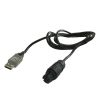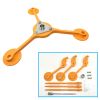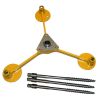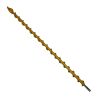Sentek Drill & Drop Soil Moisture Probe
Features
- Quick and easy undisturbed installation due to tapered shape
- Measures the true soil profile, not slurry
- Pre-normalized sensors with built-in default calibration equation
- Free ground shipping
- Expedited repair and warranty service
- Lifetime technical support
- More
Overview
The Sentek Drill & Drop is a fully encapsulated, easy-to-install soil measurement probe. Probes are available in five lengths: 10cm, 30cm, 60cm, 90cm, and 120cm, with sensors fixed at every 10cm (4”) increment. Purchase options are either with soil moisture + temperature sensors or soil moisture + temperature + salinity.
Deployment
Due to the ease of install and protected electronics, the Drill & Drop is ideally suited to situations where a monitoring probe may need to be moved between sites in short-term and annual crops. Having the electronics completely encapsulated and able to be completely buried also makes the probe suited to long-term installations, where machinery will often pass, such as dry land and feed crops. Being able to leave the probe in the ground means long-term, uninterrupted data trends, and comparison between seasons is possible.
The Drill & Drop also covers the issue of data continuity and integrity where the probe does need to be reinstalled. The ingenious tapered probe and matching auger allows direct, slurry-free, installation. This direct installation method means that the probe is measuring ‘real’ representative soil conditions immediately after install, because the surrounding soil has not been disturbed.
In The News
Monitoring Mariculture in the Gulf of Alaska
The mariculture industry in the Gulf of Alaska has been steadily growing in recent years, guided by ongoing research to help refine farm location and cultivation practices. A subset of aquaculture, mariculture focuses on rearing organisms in the open ocean. In Alaska, finfish farming is illegal, so most farms cultivate kelp, oysters, or a combination of the two. These small, locally operated farms started popping up in the Gulf of Alaska in the early 1990s, when shellfish farming first became legal. Kelp farming did not begin to catch on in the state until 2016. Many of the coastal areas that have grown interested in mariculture are historically commercial fishing communities.
Read MoreSupplying Seattle’s Drinking Water: Using Data Buoys to Monitor the Cedar River Municipal Watershed
Providing clean, safe, and reliable drinking water for the 1.6 million people in the greater Seattle area is a top priority for Seattle Public Utilities (SPU). With limited water supplies, SPU dedicates considerable resources to maintain its watersheds and mountain reservoirs. About 70 percent of Seattle Water comes from the Cedar River Municipal Watershed , and the other 30 percent comes from the South Fork Tolt River Watershed . [caption id="attachment_39574" align="alignnone" width="940"] Data buoy in Chester Morse Lake . (Credit: Kevin Johnson / Seattle Public Utilities) [/caption] Jamie Thompson, a fisheries biologist at SPU, monitors aquatic ecosystems centered on fish listed under the U.S. Endangered Species Act (ESA).
Read MoreData-Driven Advocacy on the Lower Deschutes River
Like many freshwater environments, the Deschutes River in Oregon is under pressure from development, pollution, and climate change. Many rivers, streams and lakes in the Deschutes Basin do not meet Oregon water quality standards –where state water quality monitoring assesses levels of bacteria, pH, dissolved oxygen, temperature, and fine sediment. Hannah Camel is the Water Quality Coordinator for the Deschutes River Alliance (DRA), a non-profit organization that focuses on the health of the lower 100 miles of the Deschutes River–the area most affected by human intervention. As a data-driven organization, the DRA has benefited from the installation of two NexSens X2 data loggers.
Read More




























